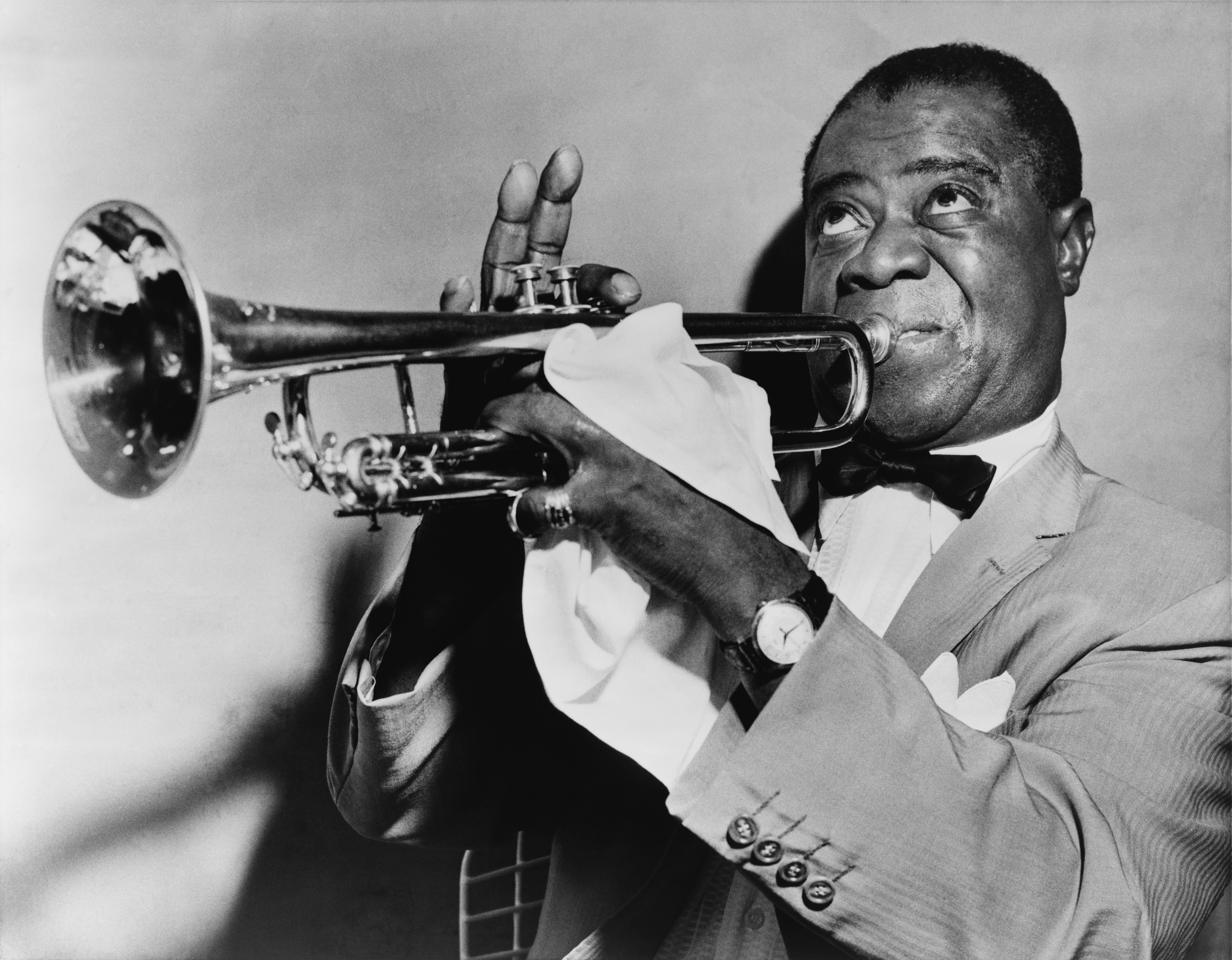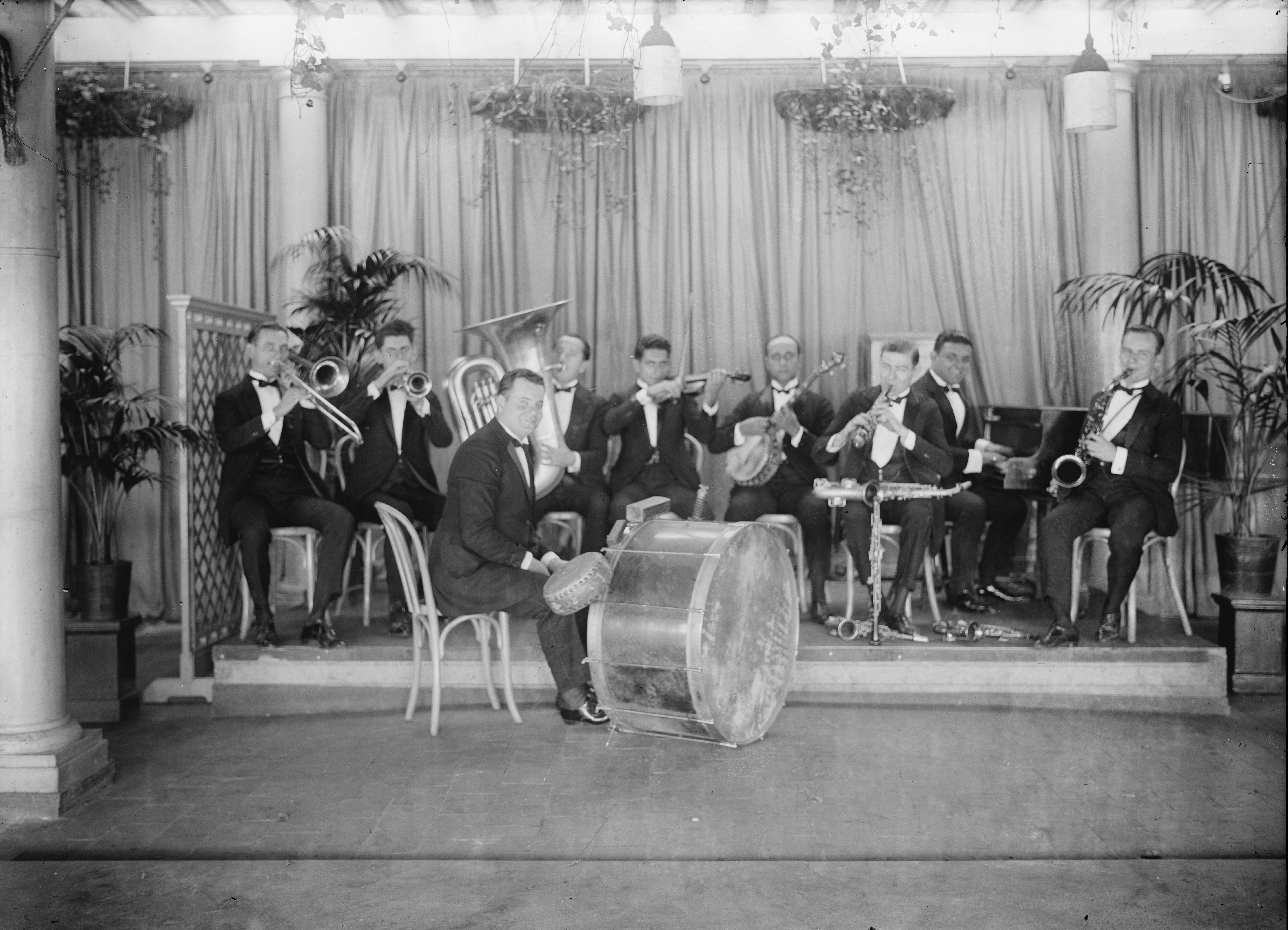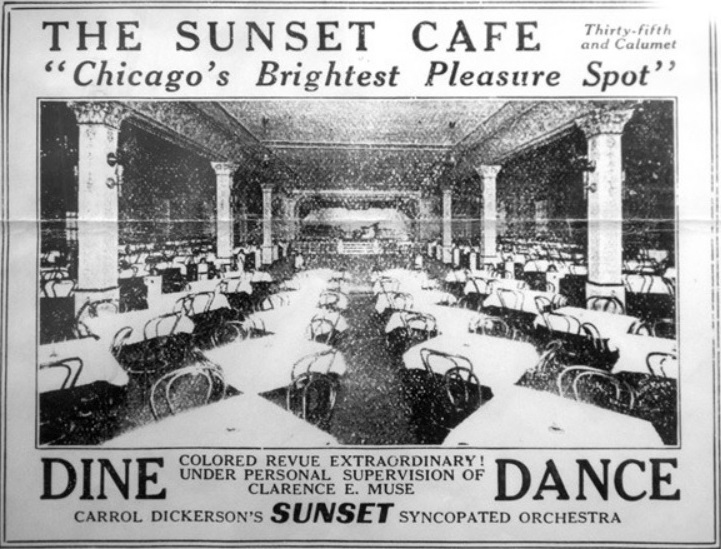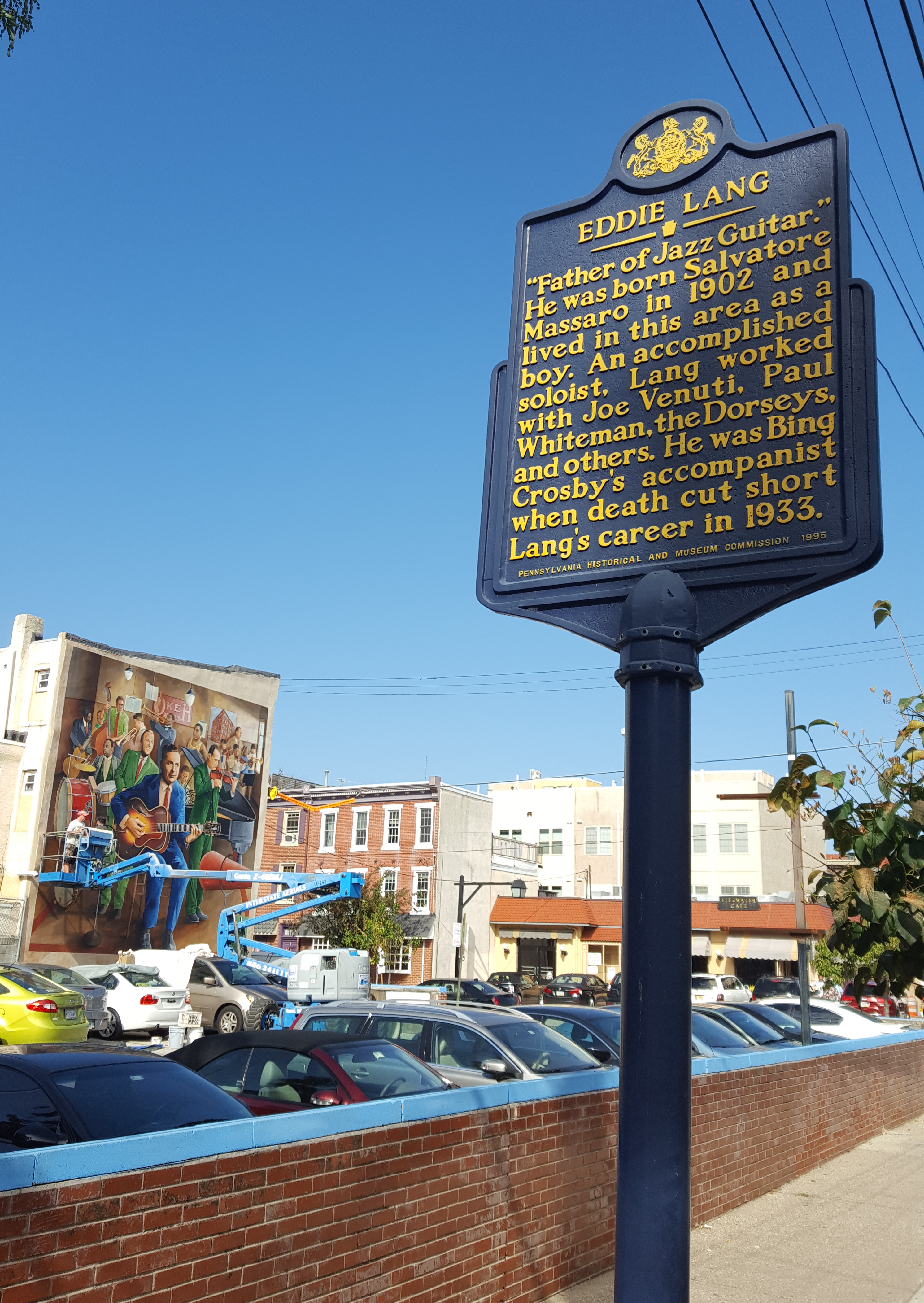|
1930s In Jazz
Swing jazz emerged as a dominant form in American music, in which some virtuoso soloists became as famous as the band leaders. Key figures in developing the "big" jazz band included bandleaders and arrangers Count Basie, Cab Calloway, Jimmy and Tommy Dorsey, Duke Ellington, Benny Goodman, Fletcher Henderson, Earl Hines, Glenn Miller, and Artie Shaw. Duke Ellington and his band members composed numerous swing era hits that have become standards: "It Don't Mean a Thing (If It Ain't Got That Swing)" (1932), "Sophisticated Lady" (1933) and "Caravan" (1936), among others. Other influential bandleaders of this period were Benny Goodman and Count Basie. Swing was also dance music. It was broadcast on the radio 'live' nightly across America for many years especially by Hines and his Grand Terrace Cafe Orchestra broadcasting coast-to-coast from Chicago, well placed for 'live' time-zones. Although it was a collective sound, swing also offered individual musicians a chance to 'solo' and imp ... [...More Info...] [...Related Items...] OR: [Wikipedia] [Google] [Baidu] |
1920s In Jazz
The period from the end of the First World War until the start of the Depression in 1929 is known as the " Jazz Age". Jazz had become popular music in America, although older generations considered the music immoral and threatening to cultural values. Dances such as the Charleston and the Black Bottom were very popular during the period, and jazz bands typically consisted of seven to twelve musicians. Important orchestras in New York were led by Fletcher Henderson, Paul Whiteman and Duke Ellington. Many New Orleans jazzmen had moved to Chicago during the late 1910s in search of employment; among others, the New Orleans Rhythm Kings, King Oliver's Creole Jazz Band and Jelly Roll Morton recorded in the city. However, Chicago's importance as a center of jazz music started to diminish toward the end of the 1920s in favor of New York. In the early years of jazz, record companies were often eager to decide what songs were to be recorded by their artists. Popular numbers in the ... [...More Info...] [...Related Items...] OR: [Wikipedia] [Google] [Baidu] |
Grand Terrace Cafe
The Sunset Cafe, also known as The Grand Terrace Cafe, was a jazz club in Chicago, Illinois operating during the 1920s, 1930s and 1940s. It was one of the most important jazz clubs in America, especially during the period between 1917 and 1928 when Chicago became a creative capital of jazz innovation and again during the emergence of bebop in the early 1940s. From its inception, the club was a rarity as a haven from segregation, since the Sunset Cafe was an integrated or "Black and Tan" club where African Americans, along with other ethnicities, could mingle freely with white Americans without much fear of reprisal. Many important musicians developed their careers at the Sunset/Grand Terrace Cafe. Original building The building that housed the Cafe still stands at 315 E 35th St in the Bronzeville neighborhood of Chicago. Originally built in 1909 as an automobile garage, after a 1921 remodelling it became a venue with around 100 tables, a bandstand and dance floor. While the hist ... [...More Info...] [...Related Items...] OR: [Wikipedia] [Google] [Baidu] |
Joe Venuti
Giuseppe "Joe" Venuti (September 16, 1903 – August 14, 1978) was an American jazz musician and pioneer jazz violinist. Considered the father of jazz violin, he pioneered the use of string instruments in jazz along with the guitarist Eddie Lang, a friend since childhood. Through the 1920s and early 1930s, Venuti and Lang made many recordings as leader and as featured soloists. He and Lang became so well known for their 'hot' violin and guitar solos that on many commercial dance recordings they were hired to do 12- or 24-bar duos towards the end of otherwise stock dance arrangements. In 1926, Venuti and Lang started recording for the OKeh label as a duet (after a solitary duet issued on Columbia), followed by "Blue Four" combinations, which are considered milestone jazz recordings. Venuti also recorded commercial dance records for OKeh under the name "New Yorkers". He worked with Benny Goodman, Adrian Rollini, the Dorsey Brothers, Bing Crosby, Bix Beiderbecke, Jack Teagard ... [...More Info...] [...Related Items...] OR: [Wikipedia] [Google] [Baidu] |
Eddie Lang
Eddie Lang (born Salvatore Massaro, October 25, 1902 – March 26, 1933) was an American musician who is credited as the father of jazz guitar. During the 1920s, he gave the guitar a prominence it previously lacked as a solo instrument, as part of a band or orchestra, and as accompaniment for vocalists. He recorded duets with guitarists Lonnie Johnson and Carl Kress and jazz violinist Joe Venuti, and played rhythm guitar in the Paul Whiteman Orchestra and was the favoured accompanist of Bing Crosby. Biography The son of an Italian-American instrument maker, Lang was born in Philadelphia, Pennsylvania, and grew up with violinist Joe Venuti. His first instrument was violin when he was seven. He performed on violin in 1917 and became a member of a trio. In 1920, he dropped the violin for banjo and worked with Charlie Kerr, then Bert Estlow, Vic D'Ippolito, and Billy Lustig's Scranton Siren Orchestra. A few years later, he dropped the banjo for guitar when he became a member ... [...More Info...] [...Related Items...] OR: [Wikipedia] [Google] [Baidu] |
Rhythm Section
A rhythm section is a group of musicians within a music ensemble or band that provides the underlying rhythm, harmony and pulse of the accompaniment, providing a rhythmic and harmonic reference and "beat" for the rest of the band. The rhythm section is often contrasted with the roles of other musicians in the band, such as the lead guitarist or lead vocals whose primary job is to carry the melody. The core elements of the rhythm section are usually the drum kit and bass. The drums and bass provide the basic pulse and groove of a song. The section is augmented by other instruments such as keyboard instruments and guitars that are used to play the chord progression upon which the song is based. The bass instrument (either double bass or electric bass guitar, or another low-register instrument, such as synth bass, depending on the group and its style of music) plays the low-pitched bassline. The bassline is a musical part that supports the chord progression, typically by playing ... [...More Info...] [...Related Items...] OR: [Wikipedia] [Google] [Baidu] |
Bal-musette
Bal-musette is a style of French instrumental music and dance that first became popular in Paris in the 1880s. Although it began with bagpipes as the main instrument, this instrument was replaced with accordion, on which a variety of waltzes, polkas, and other dance styles were played for dances. History Auvergnats settled in large numbers in the 5th, 11th, and 12th districts (''arrondissements'') of Paris during the 19th century, opening cafés and bars where patrons danced the bourrée to the accompaniment of the cabrette (a bellows-blown bagpipe locally called a "musette") and often the vielle à roue (hurdy-gurdy). Parisian and immigrant Italian musicians who played the accordion adopted the style and established themselves in Auvergnat bars especially in the 19th arrondissement.Rémi Hess : ''La valse, un romantisme révolutionnaire'', Métailié editor, Sciences humaines collection, April 2003, p. 147-148. ().Henri Joannis Deberne : ''Danser en société'', Christine Bonnet ... [...More Info...] [...Related Items...] OR: [Wikipedia] [Google] [Baidu] |
Swing Music
Swing music is a style of jazz that developed in the United States during the late 1920s and early 1930s. It became nationally popular from the mid-1930s. The name derived from its emphasis on the off-beat, or nominally weaker beat. Swing bands usually featured soloists who would improvise on the melody over the arrangement. The danceable swing style of big bands and bandleaders such as Benny Goodman was the dominant form of American popular music from 1935 to 1946, known as the swing era. The verb "to swing" is also used as a term of praise for playing that has a strong groove or drive. Musicians of the swing era include Duke Ellington, Benny Goodman, Count Basie, Cab Calloway, Jimmy Dorsey, Tommy Dorsey, Woody Herman, Harry James, Lionel Hampton, Glenn Miller, Artie Shaw and Django Reinhardt. Overview Swing has its roots in 1920s dance music ensembles, which began using new styles of written arrangements, incorporating rhythmic innovations pioneered by Louis Armstrong ... [...More Info...] [...Related Items...] OR: [Wikipedia] [Google] [Baidu] |
Gypsy Jazz
Gypsy jazz (also known as gypsy swing, jazz manouche or hot club-style jazz) is a style of small-group jazz originating from the Romani guitarist Jean "Django" Reinhardt (1910–53), in conjunction with the French swing violinist Stéphane Grappelli (1908–97), as expressed in their group the Quintette du Hot Club de France. Because its origins are in France, Reinhardt was from the Manouche (French Sinti) clan, and the style has remained popular amongst the Manouche, gypsy jazz is often called by the French name "jazz manouche", or alternatively, "manouche jazz" in English language sources. Some scholars have noted that the style was not named ''manouche'' until the late 1960s; the name "gypsy jazz" began to be used around the late 1990s. Reinhardt was foremost among a group of Romani guitarists working in Paris from the 1930s to the 1950s. The group included the brothers Baro, Sarane, and Matelo Ferret and Reinhardt's brother Joseph "Nin-Nin" Reinhardt. While his fellow g ... [...More Info...] [...Related Items...] OR: [Wikipedia] [Google] [Baidu] |
Django Reinhardt
Jean Reinhardt (23 January 1910 – 16 May 1953), known by his Romani nickname Django ( or ), was a Romani-French jazz guitarist and composer. He was one of the first major jazz talents to emerge in Europe and has been hailed as one of its most significant exponents. With violinist Stéphane Grappelli, Reinhardt formed the Paris-based Quintette du Hot Club de France in 1934. The group was among the first to play jazz that featured the guitar as a lead instrument. Reinhardt recorded in France with many visiting American musicians, including Coleman Hawkins and Benny Carter, and briefly toured the United States with Duke Ellington's orchestra in 1946. He died suddenly of a stroke in 1953 at the age of 43. Reinhardt's most popular compositions have become standards within gypsy jazz, including " Minor Swing", "Daphne", "Belleville", "Djangology", "Swing '42", and "Nuages". Jazz guitarist Frank Vignola says that nearly every major popular-music guitarist in the world has been influe ... [...More Info...] [...Related Items...] OR: [Wikipedia] [Google] [Baidu] |
Quintette Du Hot Club De France
The Quintette du Hot Club de France ("The Quintet of the Hot Club of France"), often abbreviated "QdHCdF" or "QHCF", was a jazz group founded in France in 1934 by guitarist Django Reinhardt and violinist Stéphane Grappelli and active in one form or another until 1948. One of the earliest and most significant continental jazz groups in Europe, the Quintette was described by critic Thom Jurek as "one of the most original bands in the history of recorded jazz." Their most famous lineup featured Reinhardt, Grappelli, bassist Louis Vola, and rhythm guitarists Roger Chaput and Joseph Reinhardt (Django's brother) who filled out the ensemble's sound and added occasional percussion. History According to Grappelli, the group evolved from a series of backstage jams originated by Django Reinhardt, with Stephane Grappelli, at the Hotel Claridge in Paris, where the two were engaged as members of a band led by bassist Louis Vola. After a series of informal jam sessions at the Hotel Claridge, c ... [...More Info...] [...Related Items...] OR: [Wikipedia] [Google] [Baidu] |
Lester Young
Lester Willis Young (August 27, 1909 – March 15, 1959), nicknamed "Pres" or "Prez", was an American jazz tenor saxophonist and occasional clarinetist. Coming to prominence while a member of Count Basie's orchestra, Young was one of the most influential players on his instrument. In contrast to many of his hard-driving peers, Young played with a relaxed, cool tone and used sophisticated harmonies, using what one critic called "a free-floating style, wheeling and diving like a gull, banking with low, funky riffs that pleased dancers and listeners alike". Known for his hip, introverted style, he invented or popularized much of the hipster jargon which came to be associated with the music. Early life and career Lester Young was born in Woodville, Mississippi, on August 27, 1909. to Lizetta Young (née Johnson), and Willis Handy Young, originally from Louisiana. Lester had two siblings – a brother, Leonidas Raymond, known as Lee Young, who became a drummer, and a sister, Irma ... [...More Info...] [...Related Items...] OR: [Wikipedia] [Google] [Baidu] |
Kansas City Jazz
Kansas City jazz is a style of jazz that developed in Kansas City, Missouri during the 1920s and 1930s, which marked the transition from the structured big band style to the much more improvisational style of bebop. The hard- swinging, bluesy transition style is bracketed by Count Basie, who in 1929 signed with Bennie Moten's Kansas City Orchestra, and Kansas City native Charlie Parker, who ushered in the bebop style in America. It has been said that while New Orleans was the birthplace of jazz, "America's music" grew up in Kansas City. Thus, Kansas City is known as one of the most popular "cradles of jazz". Other cities include New Orleans, Chicago, St. Louis, Pittsburgh, Philadelphia, and New York City. Kansas City was known for the organized musicians of the Local 627 A.F.M., which controlled a number of venues in the city. Background The first band from Kansas City to acquire a national reputation was the Coon-Sanders Original Nighthawk Orchestra, a white group which broadcas ... [...More Info...] [...Related Items...] OR: [Wikipedia] [Google] [Baidu] |






.jpg)
.jpg)
.jpg)
